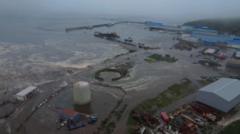A potent 8.8 magnitude earthquake struck off the coast of Russia's Kamchatka Peninsula, leading to immediate tsunami alerts across the Pacific region. The tremor hit at approximately 11:25 AM local time (00:25 AM BST) on Wednesday, marking one of the most intense quakes on record. Subsequently, millions of residents in nations such as Japan and Russia, along with parts of the United States' west coast, have been urged to evacuate. Alerts have also reached as far as China, Indonesia, New Zealand, and even countries like Peru and Mexico.
Witnesses have shared videos showcasing the aftermath of the earthquake, particularly in the town of Severo-Kurilsk, Russia, where buildings faced the onrush of large waves. Local authorities reported flooding at both the port and a fish processing facility, alongside damage to the power infrastructure in the Sakhalin region. In Japan, around 1.9 million people received evacuation orders, with officials advising residents to seek higher ground. Meanwhile, Hawaii's officials alert the public to potential 10-foot waves but indicate no significant wave action has yet occurred, stressing it may take several hours for an official clearance.
The evolving situation leaves uncertainty about the possible damage from the tsunami waves that continue traversing the Pacific. According to experts, the impact will depend significantly on how the energy radiates from the earthquake's epicenter. Not all coastlines will experience the same level of consequences, with significant variations expected based on geography.
The timing of the tsunami's arrival is under observation, with predictions that waves may touch parts of British Columbia and California in the early morning hours following the quake, with possible impacts on Nome, Alaska, shortly after. Authorities note that tsunami waves travels at jet-like speeds, offering another lens through which to anticipate their arrival.
The earthquake, occurring at a relatively shallow depth of 19.3 km (12 miles), has since been recognized as the sixth most severe in history, sharing this notoriety with other significant earthquakes, including those in Chile and Ecuador. Comparatively, the devastating 2004 Indian Ocean earthquake, classified as a 9.2-9.3 magnitude earthquake, remains a stark reminder of the potential devastation that seismic events can unleash.
Witnesses have shared videos showcasing the aftermath of the earthquake, particularly in the town of Severo-Kurilsk, Russia, where buildings faced the onrush of large waves. Local authorities reported flooding at both the port and a fish processing facility, alongside damage to the power infrastructure in the Sakhalin region. In Japan, around 1.9 million people received evacuation orders, with officials advising residents to seek higher ground. Meanwhile, Hawaii's officials alert the public to potential 10-foot waves but indicate no significant wave action has yet occurred, stressing it may take several hours for an official clearance.
The evolving situation leaves uncertainty about the possible damage from the tsunami waves that continue traversing the Pacific. According to experts, the impact will depend significantly on how the energy radiates from the earthquake's epicenter. Not all coastlines will experience the same level of consequences, with significant variations expected based on geography.
The timing of the tsunami's arrival is under observation, with predictions that waves may touch parts of British Columbia and California in the early morning hours following the quake, with possible impacts on Nome, Alaska, shortly after. Authorities note that tsunami waves travels at jet-like speeds, offering another lens through which to anticipate their arrival.
The earthquake, occurring at a relatively shallow depth of 19.3 km (12 miles), has since been recognized as the sixth most severe in history, sharing this notoriety with other significant earthquakes, including those in Chile and Ecuador. Comparatively, the devastating 2004 Indian Ocean earthquake, classified as a 9.2-9.3 magnitude earthquake, remains a stark reminder of the potential devastation that seismic events can unleash.
















